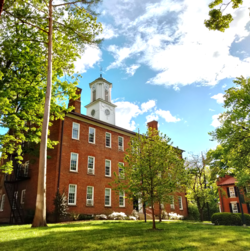
Ohio University, often called Ohio or sometimes OU, is a public research university in Athens, Ohio. The first university chartered by an Act of Congress and the first to be chartered in Ohio, the university was chartered in 1787 by the Congress of the Confederation and subsequently approved for the territory in 1802 and state in 1804, opening for students in 1809. Ohio University is the oldest university in Ohio and among the oldest public universities in the United States.
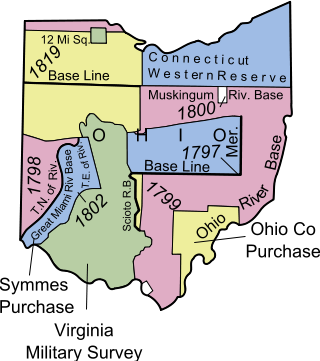
The Ohio Company of Associates, also known as the Ohio Company, was a land company whose members are today credited with becoming the first non-Native American group to permanently settle west of the Allegheny mountains. In 1788 they established Marietta, Ohio, as the first permanent settlement of the new United States in the newly organized Northwest Territory.

Capital University is a private university in Bexley, Ohio, United States. Capital was founded as the Theological Seminary of the Evangelical Lutheran Synod of Ohio in 1830 and later was associated with that synod's successor, the American Lutheran Church. The university has undergraduate and graduate programs, as well as a law school. Capital University is the oldest university in Central Ohio and is one of the oldest and largest Lutheran-affiliated universities in North America.

Manasseh Cutler was an American Congregational clergyman involved in the American Revolutionary War. He was influential in the passage of the Northwest Ordinance of 1787 and wrote the section prohibiting slavery in the Northwest Territory. Cutler was also a member of the United States House of Representatives. Cutler is "rightly entitled to be called 'The Father of Ohio University.'"

University, Hayes and Orton Halls are three historic buildings on the Oval at the Ohio State University in Columbus, Ohio. On July 16, 1970, they were added to the National Register of Historic Places. The original University Hall was demolished in 1971, and removed from the National Register that year.

Connecticut Hall is a Georgian building on the Old Campus of Yale University. Completed in 1752, it was originally a student dormitory, a function it retained for 200 years. Part of the first floor became home to the Yale College Dean's Office after 1905, and the full building was converted to departmental offices in the mid-twentieth century. It is currently used by the Department of Philosophy, and its third story contains a room for meetings of the Yale Faculty of Arts & Sciences, the academic faculty of Yale College and the Graduate School.

Old Queens is the oldest extant building at Rutgers University and is the symbolic heart of the university's campus in New Brunswick in Middlesex County, New Jersey in the United States. Rutgers, the eighth-oldest college in the United States, was founded in 1766 during the American colonial period as Queen's College. Queen's College was named for Charlotte of Mecklenburg-Strelitz, the daughter of a German duke who became the queen consort of British king George III. Old Queens is located on a six-acre hilltop city block bounded by Somerset Street, Hamilton Street, College Avenue and George Street that was previously an apple orchard. Donated to the college in 1807 by James Parker, Jr., this city block become known the Queen's Campus and is the historic core of the university. Because of this, by metonymy, the name "Old Queens" came to be used as a reference to Rutgers College and is often invoked as an allusive reference to the university or to its administration.
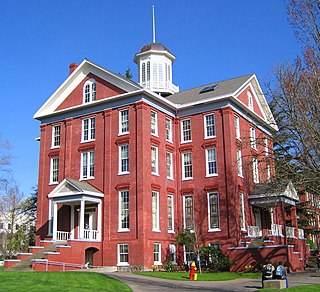
Waller Hall is a building on the campus of Willamette University in Salem, Oregon, in the United States. Opened in 1867 as University Hall, it is the oldest higher-education building west of the Mississippi River still in use, currently housing the university's administrative offices.

University Hall is the first and oldest building on the campus of Brown University in Providence, Rhode Island. Built in 1770, the building is one of only seven extant college buildings built prior to the American Revolution. According to architectural historian Bryant F. Tolles Jr., the structure is "one of the genuine icons of early American collegiate architecture."

The Main Building of Vassar College is the oldest surviving building on its campus in Poughkeepsie, New York, and the center of academic life. It was built by James Renwick, Jr. in the Second Empire style in 1861, the second building in the history of what was one of America's first women's colleges. It is one of the earliest, largest, and most important examples of Second Empire architecture in the United States and is a National Historic Landmark for its architecture and educational significance. At the time of its completion, the structure contained the most interior space of any building in the United States, and housed the entire college, including dormitories, libraries, classrooms, and dining halls. Currently, the first and second floors house campus administration while the remaining three house student rooms.
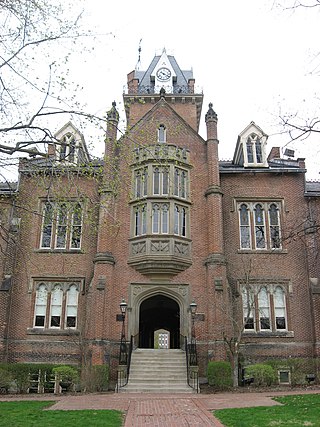
Old Main, Bethany College is a historic building group on the Bethany College campus in Bethany, West Virginia.

North Hall was the University of Wisconsin's first building. Built in 1851 in the woods and brush that would become Bascom Hill, this one building was the UW for its first four years, housing both dorm rooms and lecture halls. John Muir resided in North Hall when he was a student at the university from 1860 to 1863.

Pennsylvania Hall is the Gettysburg College central administrative building and the college's oldest building. Designed in 1835 by John Cresson Trautwine, it was built in 1838 as a "temple-style edifice with four columns in the portico".

McMillan Hall is a building on the campus of Washington & Jefferson College in Washington, Pennsylvania, United States. Built in 1793, it is the only surviving building from Washington Academy. It is the eighth-oldest academic building in the United States that is still in use for its original academic purpose and is the oldest surviving college building west of the Allegheny Mountains.

Morrill Hall is the oldest continuously-used academic building on the campus of the University of Maryland, College Park. Built in 1898 in the Second Empire architectural style for $24,000, it was the sole academic building left untouched by The Great Fire of 1912 which devastated almost all of campus. Originally known as Science Hall, the building was renamed for Senator Justin Morrill, father of the Morrill Land-Grant Colleges Act. Morrill Hall has housed numerous departments over the years, including the Zoology and Veterinary Science Departments. The three-story building currently houses a number of offices in the College of Behavioral and Social Sciences, including the Center for American Politics and Citizenship. Morrill Hall is currently being considered for addition to the Prince George's County historic landmark list. It most recently underwent a renovation in 2003.
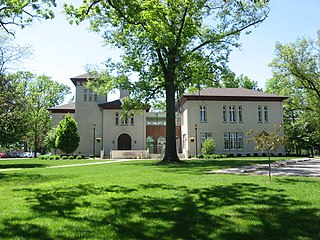
The Urbana College Historic Buildings are a historic district on the campus of Urbana University in Urbana, Ohio, United States. Composed of three nineteenth-century buildings, the district includes the oldest structures on the university's campus.

Ephraim Cutler was an early Northwest Territory and Ohio political leader and jurist.

Woodburn Circle, also known as WVU Quadrangle, is part of the downtown campus of West Virginia University, located in Morgantown, West Virginia, United States. The circle, in reality a quadrangle grouped around an oval path, is a historic and distinctive architectural assembly of three collegiate buildings, which evolved in the late 19th century. In chronological order these are Martin Hall, Woodburn Hall, and Chitwood Hall. The largest of the buildings, Woodburn Hall, has become the best known and is a symbol of the university.
History of Ohio University, compiled by numerous authors, predates its founding, as a part of the post-Revolutionary period that saw the nation's first land grants and continues through stages of conflict and change into standardization, digital advents, widespread research, and its present survival with strategic research, retrenchment, and impactful upgrades. Most of the content on this article is from Ohio University 1804–2004: Spirit of a Singular Place by Betty Hollow.
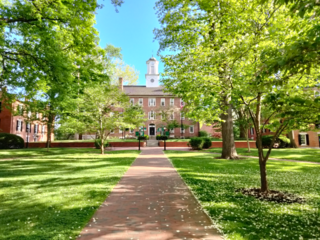
The College Green of Ohio University is the university's centralized quadrangle lawn which saw the first academic buildings in the former Northwest Territory. The yard sits roughly aligned to cardinal directions, with Manasseh Cutler Hall facing true north. The Green, at the heart of the Athens campus, is surrounded by administrative, academic, and library buildings named for figures that played pivotal roles in university history: Manasseh Cutler, Robert Wilson, William McGuffey, and Vernon Alden to name a few. The most prominent three structures which adorn College Green, all over 200 years old and made of red brick, are featured on the official university logo and set the university's Federal appearance: Cutler Hall, originally constructed in 1816 as the College Edifice but not officially open until 1819 due to a fire, is the home of the President's office; Wilson Hall built 1837 houses the College of Arts & Sciences; and McGuffey Hall was built 1839. For most of the nineteenth and twentieth century, College Green saw small memorials and wartime monuments dedicated in remembrance of the people involved in those centuries' great conflicts. The Green is the centerpiece of a historic district listed on the National Register of Historic Places in 1979, encompassing the collegiate yard, flanking buildings, and other nearby campus buildings.
